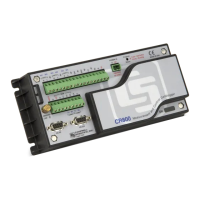Section 7. Installation
265
Figure Running-Average Frequency Response (p. 266) is a graph of signal
attenuation plotted against signal frequency normalized to 1/(running average
duration). The signal is attenuated by a synchronizing filter with an order of 1
(simple averaging): Sin(πX) / (πX), where X is the ratio of the input signal
frequency to the running-average frequency (running-average frequency = 1 /
time length of the running average).
Example:
Scanperiod=1ms,
Nvalue=4(numberofpointstoaverage),
Running‐averageduration=4ms
Running‐averagefrequency=1/(running‐averageduration=250Hz)
Input‐signalfrequency=100Hz
Inputfrequencytorunningaverage(normalizedfrequency)=10
0/250
=0.4
Sin(0.4π)/(0.4π)=0.757(orreadfromfigureRunning‐Average
FrequencyResponse
(p.266),wheretheXaxisis0.4)
Fora100‐HzinputsignalwithanAmplitudeof10‐Vpeaktopeak,a
runningaverageoutputsa100‐Hzsignalwithanamplitudeof7.57‐V
peaktopeak.
There is also a phase shift, or delay, in the AvgRun() output. The formula for
calculating the delay, in number of samples, is:
Delayinsamples=(N‐1)/2
Note N = Number of points in running average)
To calculate the delay in time, multiply the result from the above equation by the
period at which the running average is executed (usually the scan period):
Delayintime=(scanperiod)(N‐1)/2
For the example above, the delay is:
Delayintime=(1ms)(4‐1)/2=1.5ms
Example:
Actualtestusinganaccelerometermountedonabeamwhoseresonant
frequencyisabout36Hz.Themeasurementperiodwas2ms.The
runningaveragedurationwas20ms(fre
quencyof50Hz),sothe
normalizedresonantfrequencyis,
36/50=0.72,SIN(0.72π)/(0.72π)=0.34.

